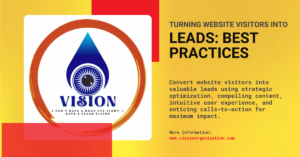Turning Website Visitors into Leads: Best Practices – Introduction:
In the digital landscape, generating leads from website visitors is a crucial aspect of any successful online marketing strategy. By implementing effective lead generation techniques, businesses can capture valuable information from their website visitors, nurture them through the sales funnel, and ultimately convert them into loyal customers. This process is often referred to as lead nurturing, and it involves building a relationship with potential customers over time, providing them with valuable information and offers, and guiding them toward making a purchase.
One of the most effective ways to generate leads from your website is to offer a lead magnet, such as a free e-book, whitepaper, or trial of your product or service. This can be done through a landing page, which is a standalone web page that is designed specifically to capture leads. The landing page should be optimized for conversions, with a clear call-to-action and a form that makes it easy for visitors to provide their contact information.
Another best practice for generating leads from your website is to use retargeting ads. Retargeting allows you to show ads to people who have previously visited your website, reminding them of your brand and encouraging them to return and take action. This can be particularly effective for businesses with longer sales cycles, as it helps to keep your brand top of mind and nurture leads over time. Additionally, using social media platforms to promote your lead magnets and retargeting ads can help increase your reach and generate more leads.
- Create Compelling Content:
Craft compelling and resonant content that captivates your intended audience. Offer valuable resources such as eBooks, whitepapers, and webinars to entice visitors to provide their contact information.
- Optimize Your Website for Lead Generation:
Implement clear and prominent calls-to-action (CTAs) on your website to guide visitors toward taking action. Use landing pages with forms to capture lead information in exchange for valuable content or offers.
- Utilize Lead Magnets:
Offer lead magnets like downloadable resources, free trials, or product demonstrations to encourage visitors to engage with your brand. Tailor your lead magnets to different stages of the customer journey to attract leads at various points in the buying process.
- Leverage Social Media and Referral Programs:
Engage with your audience on social media platforms to build relationships and drive traffic to your website. Create a referral program that incentivizes existing customers to refer new leads, expanding your reach organically.
- Implement Live Chat Services:
Provide real-time support through live chat services to engage with visitors and address their queries promptly. Use live chat as a tool to capture lead information and guide visitors towards conversion.
- Optimize Your Website for SEO:
Conduct keyword research and create blog posts around relevant topics to attract organic traffic. Optimize your website for search engines to improve visibility and attract leads actively searching for solutions.
- Track and Analyze Lead Generation Efforts:
Leverage analytics to track and optimize your lead-generation efforts. Continuously analyze data to refine your approach and improve lead conversion rates over time.

By following these best practices, businesses can effectively turn website visitors into leads, nurture them through the sales funnel, and drive conversions. Remember, successful lead generation requires a strategic approach, consistent effort, and a deep understanding of your target audience’s needs and preferences.
Effective lead generation is crucial for any business looking to grow its customer base and increase revenue. By following best practices, businesses can transform website visitors into leads, guide them through the sales funnel, and ultimately drive conversions. One of the most important aspects of lead generation is understanding your target audience’s needs and preferences. This can be achieved through market research, customer surveys, and analyzing website analytics. By tailoring your content and messaging to your audience, you can more effectively engage and convert them into leads.

